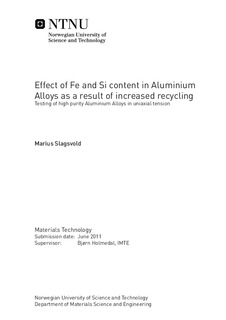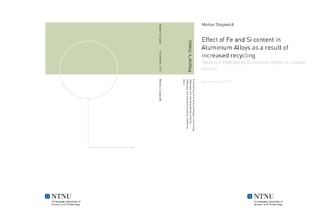| dc.contributor.advisor | Holmedal, Bjørn | nb_NO |
| dc.contributor.author | Slagsvold, Marius | nb_NO |
| dc.date.accessioned | 2014-12-19T13:25:54Z | |
| dc.date.available | 2014-12-19T13:25:54Z | |
| dc.date.created | 2012-04-20 | nb_NO |
| dc.date.issued | 2011 | nb_NO |
| dc.identifier | 517081 | nb_NO |
| dc.identifier | ntnudaim:6610 | nb_NO |
| dc.identifier.uri | http://hdl.handle.net/11250/248941 | |
| dc.description.abstract | The recycling of aluminium from used aluminium scrap leads to an unavoidable presence of pollutions in the form of elements of various amounts. Two such elements are iron and silicon. These will always be present to some extent in an aluminium alloy as they are introduced to the alloy during processing. Iron and silicon are accumulative elements, meaning that they can never be completely eliminated once introduced into the aluminium. Some alloys have very narrow compositional windows, they have strict regulations concerning amount of alloying elements allowed. This is of grave importance for the recycling process; to be able to produce specific alloys with limitations regarding content and mechanical properties. A project to uncover the effects of common elements in aluminium such as Mg, Si and Fe has been initiated by the industry. This work is closely related to the project and was carried out as a report during fall 2010 and continued as a master thesis during spring 2011. The aim of this work was to study the effects of variation of small amounts of iron and silicon in 4 different alloys of high and ultra high purity (>99.7 and >99.999 wt% Al, respectively). The main focus was to uncover the effect of the elements on mechanical properties. Tensile test experiments with specimens in uniaxial tension were conducted to uncover the mechanical properties of the alloys. In addition to the tensile tests other parameters like texture, particles, recrystallisation and micro structure development were investigated. DC-cast, extruded flat profiles and rolled and recrystallised versions of the 4 alloys were used during the work.The results from tensile tests performed on the rolled and recrystallised aluminium showed that an initial introduction of 0.066 wt % Fe and Si 0.068 wt % to an alloy containing no pollutions lead to a dramatic increase in strength properties (up to 100% for the tensile strength) and a mild decrease in elongation. The increased strength properties and reduced formability was traced to iron and silicon in solid solution. From the same tensile tests it was concluded that a further increase of iron and an introduction of a small amount of pollutions had close to no effect on the mechanical properties. | nb_NO |
| dc.language | eng | nb_NO |
| dc.publisher | Institutt for materialteknologi | nb_NO |
| dc.subject | ntnudaim:6610 | no_NO |
| dc.subject | MIMT Materialteknologi | no_NO |
| dc.subject | Materialutvikling og -bruk | no_NO |
| dc.title | Effect of Fe and Si content in Aluminium Alloys as a result of increased recycling: Testing of high purity Aluminium Alloys in uniaxial tension | nb_NO |
| dc.type | Master thesis | nb_NO |
| dc.source.pagenumber | 120 | nb_NO |
| dc.contributor.department | Norges teknisk-naturvitenskapelige universitet, Fakultet for naturvitenskap og teknologi, Institutt for materialteknologi | nb_NO |

